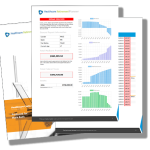Picture this: you’re a retiree living on a fixed income, and the cost of everything from groceries to gas seems to be climbing. You wonder how much your Social Security increase 2024 will help offset these rising costs.
Sounds familiar?
This is an everyday reality for millions of Americans depending on Social Security benefits. So what can we expect in terms of Social Security increases come 2024? How does it all work?
In this post, we’ll dive into the world of Social Security Cost-of-Living Adjustments (COLAs), exploring its calculation methodology and history. We’ll also examine inflation’s impact on benefits and compare COLA growth with wage development over time.
Stick around if you want actionable strategies that could potentially maximize your benefit despite escalating expenses.
Understanding Social Security Cost-of-Living Adjustments (COLAs)
The heart of social security benefits is the annual cost-of-living adjustment, or COLA. These yearly changes are vital for keeping up with inflation and ensuring beneficiaries maintain their buying power.
What is a COLA and why it matters
A COLA, simply put, helps your Social Security benefits keep pace with rising costs. It’s like an escalator in a shopping mall that moves you upwards as prices rise around you.
This safety mechanism becomes more important when we consider fixed incomes of retirees. The estimated Social Security COLA for 2024 is about 3.2%. This means average monthly retiree benefit might increase by roughly $57 – think two extra steak dinners each month.
Critical Role of Consumer Price Data
So how does the Social Security Administration figure out these adjustments? The SSA looks to the BLS for info on changes in typical costs, such as food, medical care, housing and apparel.
Inflation – The Silent Eroder
Rising costs can silently erode your purchasing power if left unchecked – much like termites eating away at wood unnoticed. Hence, COLAs aim to protect recipients against this silent threat called inflation which often hits harder on seniors due to higher healthcare needs.
How Social Security COLAs Are Calculated
The COLA, an annual adjustment of Social Security benefits to account for inflation, is a crucial element in providing financial security for retirees. But how exactly are these adjustments calculated?
Role of CPI-W in calculating COLAs
To start with, let’s look at one crucial factor – the Consumer Price Index for Urban Wage Earners and Clerical Workers (CPI-W). This index measures price changes experienced by urban wage earners and clerical workers. It plays an instrumental role in determining each year’s Social Security COLA.
In simple terms, if prices go up according to this index data, so does your Social Security benefit payment. Specifically speaking about 2024 predictions: The inflation gauge used by the SSA rose at a 2.6% annual rate for July and 3.4% for August which will influence next year’s adjustment.
All forms of Social Security benefits, including retirement, disability insurance payments etc., are affected by this increase decided based on CPI-W numbers every October.
This process might seem complicated but remember it serves to protect beneficiaries against rising costs due to inflation. That means extra cash in your pocket when you need it most.
Table of Contents:
- Understanding Social Security Cost-of-Living Adjustments (COLAs)
- How Social Security COLAs Are Calculated
- The Impact of Inflation on Social Security Benefits
- The History of Social Security COLAs
- Comparing Social Security COLAs to Wage Growth
- The Future of Social Security COLAs
- Strategies for Maximizing Social Security Benefits
- FAQs in Relation to Social Security Increase 2024
- What is the projected Social Security increase for 2024?
- How will the Social Security increase be determined in 2024?
- Will the Social Security increase be applied to all beneficiaries in 2024?
- How can I plan for a potential Social Security increase in 2024?
- Are there any strategies to maximize my benefits from a potential Social Security increase in 2024?
- Conclusion
The Impact of Inflation on Social Security Benefits
When inflation bites, the buying power of your Social Security benefits can shrink. But how does this really work? Let’s explore.
Inflation and the cost of living for retirees
Consider the cost of a loaf of bread that has risen from $1 to $1.04 due to inflation, but your Social Security benefit increased by only 2%, meaning you’d have an extra two cents in your pocket – not enough to cover the difference. Next year, due to inflationary pressures, that same loaf of bread may cost $1.04 – but if your social security payment only rises by a measly 2%, you’ll just have an additional two cents in your pocket. That’s not enough to cover the rising costs.
This is where BLS data released Wednesday comes into play – providing us with vital consumer price data which tells us that August inflation grew 3.7% from one year ago. What we’ve seen is similar increases across services including food and other necessities causing seniors’ purchasing power to decline even more dramatically than expected because their retirement benefit payments aren’t keeping pace.
The average monthly retiree sees these impacts first-hand as they juggle their fixed incomes against these rising prices.
Luckily, COLA or Cost-of-Living Adjustments are designed specifically to help counteract these effects so our senior citizens don’t get left behind amidst rising prices every year.
The History of Social Security COLAs
Examining the history of Social Security Cost-of-Living Adjustments (COLAs), it’s clear that they play a pivotal role in maintaining beneficiaries’ buying power. With rising costs, especially for services including food and healthcare, these adjustments have been vital.
In fact, one notable advocacy group working on behalf of senior citizens is the Senior Citizens League. They’ve highlighted how essential large COLAs are to retirees living on fixed incomes. Without such increases, social security payments may not keep pace with inflation rates.
Prior years saw some significant fluctuations in annual COLA estimates. The Senior Citizens League provides an excellent resource for this historical data at their website. However, it’s important to note that each year’s increase takes effect with December’s Social Security payments.
Figures from the Bureau of Labor Statistics have demonstrated regular hikes in consumer price data over recent years. For example, August 2023 marked a high point as annual cola rose significantly due to average CPI-W values being bit higher than expected during Q3.
The impact was felt most among monthly retiree benefit recipients who depend heavily on their monthly benefits.
This exploration of past patterns can assist us in predicting what the Social Security Administration may have in store for cost-of-living adjustments (COLAs). It also sheds light on why keeping tabs on official COLA announcements matters so much to every retiree out there.
Comparing Social Security COLAs to Wage Growth
If you’re a retiree, it’s crucial to understand the link between Social Security Cost of Living Adjustments (COLAs) and wage growth. Why? Because your purchasing power hangs in the balance.
Disparity between Wage Growth and Benefit Increases
You might have noticed that costs are climbing faster than your benefits. You’re not alone; many retirees share this sentiment. According to data from the Urban Institute, urban wage earners often experience a rise in their earnings, while those depending on social security see less significant increases.
The stats back this up too. The cost of goods and services for retirees is increasing faster than Social Security benefits. So what gives?
The problem lies with how benefit increases are calculated by the Social Security Administration (SSA). While wage growth tends to mirror economic trends more closely, SSA uses an inflation measure called CPI-W which doesn’t always reflect real-world price hikes experienced by senior citizens.
This disparity can lead us down some interesting paths when planning for retirement income stability – but don’t worry. With knowledge comes power – so let’s keep digging into these details.
The Future of Social Security COLAs
When it comes to Social Security increases in 2024, the buzzword is ‘COLA’. But what does this mean for your retirement? Let’s take a look at the data.
According to a MarketWatch report, the Federal Reserve has recently raised interest rates. This move was made to combat inflation which economists predict will be on a downward trend by 2024.
This action could affect future cost-of-living adjustments (COLAs). As we know, these adjustments are crucial as they help protect social security recipients against rising costs and maintain their buying power.
Historically, large COLAs have been relatively rare. However, with the current economic climate being unpredictable due to factors like pandemic-related stimulus payments and supply chain issues among others; larger than usual COLA increases might become more common moving forward. This can potentially lead to increased monthly retiree benefit payments for beneficiaries under Social Security administration programs.
In fact, changes in federal reserve policies often result in official cola increase announcements that may greatly impact retirees’ financial planning strategies around fixed incomes from their social security retirement benefits.
To stay updated on such developments or any bit higher modifications about your potential average monthly retiree benefit payments or other details related specifically towards your own personal case scenario within Social Security Retirement Benefit program – it’s always wise keeping an eye out.
Strategies for Maximizing Social Security Benefits
The rising costs, including those of Alzheimer’s drugs covered by Medicare, might make you feel like a tightrope walker balancing on the high wire of retirement. But don’t fret. Here are some strategies to help average recipients maximize their Social Security benefits.
Social Security COLAs and Your Benefit Payments
Your social security benefit isn’t static; it adjusts annually with the Cost-of-Living Adjustment (COLA). For 2024, it’s predicted to be around 3.2%. This means your monthly retiree benefit could rise about $57.
A higher COLA can give your buying power a boost against inflation and rising costs. It’s like having an extra shot in your morning coffee – not necessary but certainly nice.
Mind The Earnings Test
If you’re thinking about claiming benefits before reaching full retirement age while still working, watch out for the earnings test. Income above certain levels may reduce your payments temporarily.
It’s similar to trying to fill a bucket with holes – unless you plug them up (limiting income), water will keep escaping (reduced benefits).
Taking Advantage Of Delayed Retirement Credits
If possible, consider delaying taking Social Security until after your full retirement age. Each year delayed results in roughly an 8% increase in future monthly payments – kind of like baking cookies longer for extra crispiness.
For more personalized advice based on individual circumstances or complex situations involving spousal or survivor benefits, reach out to professionals at Healthcare Retirement Planner.
FAQs in Relation to Social Security Increase 2024
What is the projected Social Security increase for 2024?
The estimated Social Security COLA increase for 2024 hovers around 3.2%. This may boost average monthly benefits by about $57.
How will the Social Security increase be determined in 2024?
The SSA uses CPI-W data to determine annual COLAs. Changes in this index reflect inflation and impact how much beneficiaries receive.
Will the Social Security increase be applied to all beneficiaries in 2024?
Absolutely, all forms of social security benefits are impacted by the annual COLA adjustment.
How can I plan for a potential Social Security increase in 2024?
To prepare, consider your retirement needs alongside expected benefit increases. Factor these into budgeting and financial planning exercises.
Are there any strategies to maximize my benefits from a potential Social Security increase in 2024?
Sure thing. Stay informed on changes impacting Medicare costs like rising Alzheimer’s drug prices that might affect final benefit amounts.
Conclusion
Figuring out Social Security Cost-of-Living Adjustments (COLAs) ain’t no picnic…
But it’s essential for retirees who want to plan ahead. The social security increase 2024 could help offset inflation and rising costs, but understanding its calculation is key.
CPI-W plays an important role in this process, and keeping track of these numbers can give you insights into potential benefit changes.
Rising costs might seem daunting…
Yet remember that there are strategies available to maximize your benefits. Stay informed about economic trends and adapt as needed.
Inflation or not, knowing how COLAs work gives you power over your retirement plans!
Streamlining the Medicare Surcharge Calculation Process.
Our Healthcare Retirement Planner software is designed to streamline the retirement planning process for financial professionals. By providing an efficient way to calculate IRMAA costs, our tool helps you save time and focus on other aspects of your clients’ retirement plans.
- Faster calculations: Our software quickly calculates IRMAA costs based on your client’s income and tax filing status, eliminating manual calculations and potential errors.
- User-friendly interface: The intuitive design of our platform makes it easy for financial professionals to input data and generate results with minimal effort.
- Data integration: Seamlessly integrate our calculator into your existing financial planning tools or CRM systems for a more streamlined workflow.
- Easy to Understand Reports: Export reports to easily share with your clients
- Tax and Surcharge Modeling: see how different types of income affects both taxes and your surcharges.
In addition to simplifying the calculation process, using our Healthcare Retirement Planner can also help improve communication between you and your clients. With clear visuals that illustrate how IRMAA costs impact their overall retirement plan, you can effectively convey complex information in an easily digestible format. This enables clients to make informed decisions about their healthcare expenses during retirement while ensuring they are prepared for any potential changes in Medicare premiums due to income fluctuations. To learn more about how our software can benefit both you as a financial professional and your clients’ retirement planning experience, visit the features page. Streamlining retirement planning processes can help financial professionals save time and resources, allowing them to focus on other areas of their clients’ needs. Automated calculation of IRMAA costs is the next step in streamlining this process even further.







